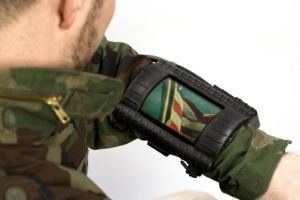Jan 14 2009
Universal Display Corporation (NASDAQ:PANL), an innovator behind today's and tomorrow's displays and lighting through its UniversalPHOLED™ phosphorescent OLED technology, today announced that it has received a $1,089,600 extension to a United States Army Communication Electronics Research and Development Engineering Center (CERDEC) Small Business Innovation Research (SBIR) Phase III contract. Under the extension, Universal Display will continue its development of flexible OLED display technology for use in military applications.
 A wrist-mounted flexible OLED display prototype that was designed by Universal Display Corporation and its partners, LG Display and L-3 Display Systems. Several of these devices were delivered to the U.S. Army for testing and evaluation under Universal Display's original Phase III U.S. Army SBIR contract. (Photo: Business Wire)
A wrist-mounted flexible OLED display prototype that was designed by Universal Display Corporation and its partners, LG Display and L-3 Display Systems. Several of these devices were delivered to the U.S. Army for testing and evaluation under Universal Display's original Phase III U.S. Army SBIR contract. (Photo: Business Wire)
The 15-month program extension will focus on the continued development and delivery of a wrist-mounted communications device prototype that contains a flexible, active-matrix OLED (AMOLED) display built on metallic foil. The AMOLED display will use an amorphous-Silicon (a-Si) TFT backplane developed and fabricated by LG Display (NYSE:LPL, KRX:034220), a leading manufacturer of thin-film transistor liquid crystal displays (TFT-LCDs) and active-matrix OLEDs. It will also incorporate advances in Universal Display's high-efficiency UniversalPHOLED technology, as well as the Company's transparent cathode technology for top emission.
The flexible AMOLED display will be shaped to fit into a housing that can be worn on the wrist, enabling the wearer to see real-time video and graphics information. Designed and built by L-3 Display Systems, a leading supplier of ruggedized display systems for military uses and a long-standing partner of Universal Display under this program, the housing for this prototype device will contain a number of advanced communications components. Intended for use by soldiers in the field, this wrist-mounted product concept also has numerous potential consumer product applications.
“Having made great strides in the development of flexible OLED display technology, we are pleased to continue our work to demonstrate the readiness of this technology for military and commercial applications,” said Steven V. Abramson, President and Chief Executive Officer of Universal Display. “Through our collaborative efforts with LG Display, a world-leading display manufacturer, and L-3 Display Systems, a leading display systems integrator for the U.S. Department of Defense, our exciting flexible OLED technology is well-positioned for insertion into both military and consumer product opportunities, such as this wrist-mounted communications device.”
“It is very important for the industries, in terms of creating new market, to constantly explore new potential in emerging technology such as flexible OLED technology,” said In Jae Chung, Executive Vice President and Chief Technology Officer of LG Display. “Our collaborative efforts with Universal Display and L-3 Display Systems have shown not only that potential is immense but that flexible OLED technology is progressively finding its path to military and commercial applications.”
“We are pleased to have this expanded opportunity to work with our long-standing partner, Universal Display, through this exciting new phase of our U.S. Army CERDEC program. This program will continue to lead to significant advances using state-of-the art flexible OLED display technology, and the integration of that display technology with our advanced communications technology could result in a ground-breaking military communications device,” said Robert McGill, president of L-3 Displays Group. “The advantages offered by this team's flexible OLED display technology create many opportunities for novel designs of portable electronic devices like this one for the U.S. Army and U.S. Air Force.”
In this continuation program, the team will specifically focus on demonstrating advances in display performance, including higher display brightness and enhanced reliability, as well as improved product design (i.e., a thinner, lighter weight and more compact system housing). Prototypes will be delivered for evaluation by military personnel for use in the field.